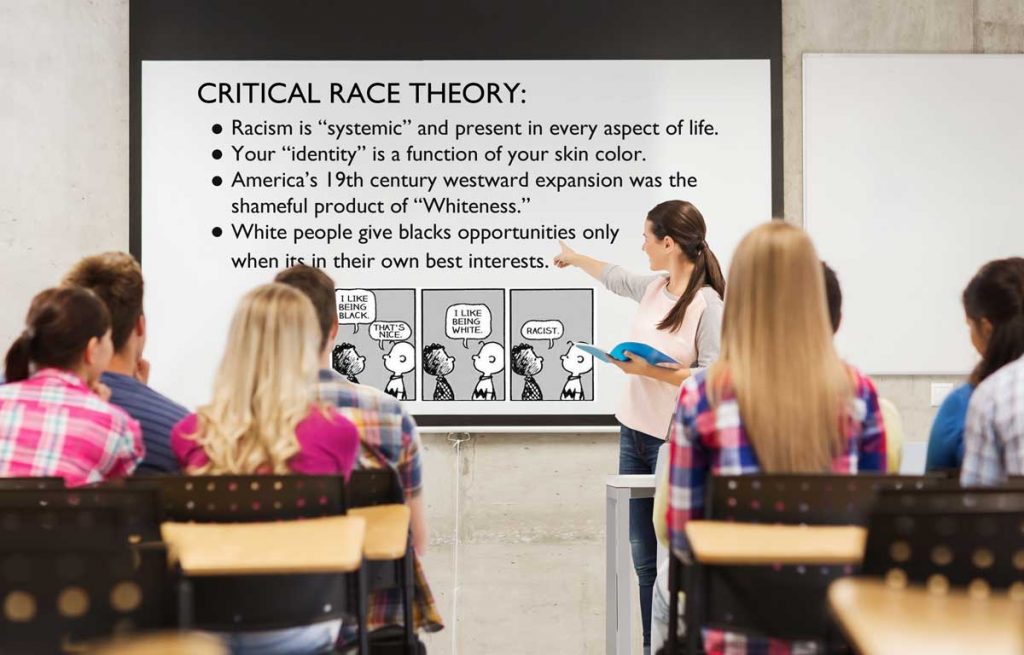
Critical Race Theory (CRT) was an intellectual development in the late 1970s and early 1980s in which some scholars, perturbed by what they perceived as a loss of momentum in the movement for racial equality, began to doubt that the constitutional and legal system itself had the capacity for change.
This criticism mirrored a Marxist attack long voiced in academia: that the Constitution had been a capitalist document incapable of allowing for the redistributionist change necessary to create a more equal world. To create a more equal world, the Constitution and the legal system would have to be endlessly criticized – hence critical theory – and torn down from within.
The Marxist criticism of the system was called critical theory; the racial criticism of the system was therefore called Critical Race Theory.
So, what does CRT believe? In their primer, Critical Race Theory, Richard Delgado (one of the movement’s founders) and Jean Stefancic set out some basic principles:
- “Racism is ordinary, not aberrational”;
- “Our system of white-over-color ascendancy serves important purposes, both psychic and material.”
When taken together, these principles have serious ramifications. First, they suggest that legal rules that stand for equal treatment under law – i.e. the 14th Amendment – can remedy “only the most blatant forms of discrimination.” The system is too corrupted, too based on the notion of white supremacy, for equal protection of the laws to ever be a reality. The system must be made unequal in order to compensate for the innate racism of the white majority.
Second, these principles suggest that even measures taken to alleviate unequal protection under the law – for example, the Supreme Court decision in Brown v. Board of Education – were actually taken for nefarious purposes, to serve white interests. This is exactly what Derrick Bell believed: he said that Brown had only been decided in order to prevent the Soviet Union from using American racial inequality as a public relations baton to wield against the white-majority United States.
There is some internal conflict within CRT, though. For example, some CRT writers seem to take the Martin Luther King, Jr. line that race is arbitrary, a social construct; the majority, however, suggest that minorities have a special status in society, and something unique to bring to the table. As Delgado and Stefancic write, “Minority status, in other words, brings with a presumed competence to speak about race and racism.”
So here’s what we’re left with, in simple terms. Racism cannot be ended within the current system; the current system is actually both a byproduct of and a continuing excuse for racism. Minority opinions on the system are more relevant than white opinions, since whites have long enjoyed control of the system, and have an interest in maintaining it.
Articles
- ‘Woke’ Catholic Schools Offer Poison in Place of the Gospel
- Catholic Schools and the Woke Revolution
- Critical race theory comes to church and my children’s Catholic schools
- Woke revolution looms for Minnesota schools
- Is CRT in Minnesota‘s Catholic Schools?
- Parents Organize to Push Back Against Critical Race Theory
- Critical Race Theory is Waking the Lions
- Critical Race Theory in Education – Christopher Rufo
- Black Lives Matter St. Paul Founder Says He ‘Resigned’ After Learning the ‘Ugly Truth’
- Why Critical Race Theory is Contrary to Catholic Education
- 10 Ways Catholic Education Counters ‘Cancel Culture’
- Protecting Our Children From Critical Race Theory
- Revitalizing Local Democracy: The Case for On-Cycle Local Elections
Resources
- CRT Briefing Book
- Center for the American Experiment
- Stop K-12 Indoctrination
- Conversations on Critical Race Theory
- Gold standard for state legislation
- Toolkit for parents
Examples
- Edina Schools on Black Lives Matter
- Bloomington School Board Resolution
- Bloomington Activist Group Statement
- Minnetonka Activist Group Statement
- Muslim Activist Group Statement

